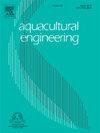Design and performance of a zero-discharge integrated multi-trophic aquaculture recirculation system for the intensive culture of whiteleg shrimp (Litopenaeus vannamei)
IF 4.3
2区 农林科学
Q2 AGRICULTURAL ENGINEERING
引用次数: 0
Abstract
This study examines the performance of the Multi-Trophic Aquaculture Recirculating System (IMTA-RAS) over a 124-day production cycle, evaluating its water quality parameters, nutrient utilization efficiency, and economic feasibility. The system comprised three identical setups, integrating the cultivation of whiteleg shrimp (Litopenaeus vannamei), tilapia (Oreochromis niloticus), green seaweed (Cladophora glomerata), and red seaweed (Gracilaria tenuistipitata) within a closed-loop system. Results demonstrated stable water quality, reduced operational costs, and enhanced profitability. The system yielded 6.9 kg m−2 shrimp, 3.1 kg m−3 fish, 5.3 kg m−2 green seaweed, and 5.2 kg m−2 red seaweed, with survival rates of 62.2 % for shrimp and 100 % for fish. Furthermore, feed accounted for 89.4 % of dry matter (DM), 91 % nitrogen (N), and 95.4 % phosphorus (P), with recorded retention rates of 40.3 % DM, 45.9 % N, and 27.6 % P within production outputs. These findings reinforce the IMTA-RAS model’s scalability potential, offering a sustainable framework for commercial shrimp farming through enhanced nutrient reutilization, reduced water exchange, and improved biosecurity.
凡纳滨对虾集约化养殖零排放综合多营养循环水系统的设计与性能
本研究考察了多营养养殖循环水系统(IMTA-RAS)在124天生产周期内的性能,评估了其水质参数、养分利用效率和经济可行性。该系统包括三个相同的设置,将白对虾(Litopenaeus vannamei)、罗非鱼(Oreochromis niloticus)、绿海藻(Cladophora glomerata)和红海藻(Gracilaria tenuistipitata)的培养整合在一个闭环系统中。结果表明,水质稳定,降低了运营成本,提高了盈利能力。 公斤6.9系统产生 m−2虾, 公斤3.1 m−3鱼, 公斤5.3 m−2绿色海藻,和5.2 公斤 m−2红色海藻,生存率为62.2 100 % %虾和鱼。饲料对干物质(DM)、氮(N)和磷(P)的贡献率分别为89.4% %、91% %和95.4 %,分别为40.3% % DM、45.9% % N和27.6% % P。这些发现加强了IMTA-RAS模型的可扩展性潜力,通过加强养分再利用、减少水交换和提高生物安全性,为商业虾养殖提供了可持续的框架。
本文章由计算机程序翻译,如有差异,请以英文原文为准。
求助全文
约1分钟内获得全文
求助全文
来源期刊

Aquacultural Engineering
农林科学-农业工程
CiteScore
8.60
自引率
10.00%
发文量
63
审稿时长
>24 weeks
期刊介绍:
Aquacultural Engineering is concerned with the design and development of effective aquacultural systems for marine and freshwater facilities. The journal aims to apply the knowledge gained from basic research which potentially can be translated into commercial operations.
Problems of scale-up and application of research data involve many parameters, both physical and biological, making it difficult to anticipate the interaction between the unit processes and the cultured animals. Aquacultural Engineering aims to develop this bioengineering interface for aquaculture and welcomes contributions in the following areas:
– Engineering and design of aquaculture facilities
– Engineering-based research studies
– Construction experience and techniques
– In-service experience, commissioning, operation
– Materials selection and their uses
– Quantification of biological data and constraints
 求助内容:
求助内容: 应助结果提醒方式:
应助结果提醒方式:


